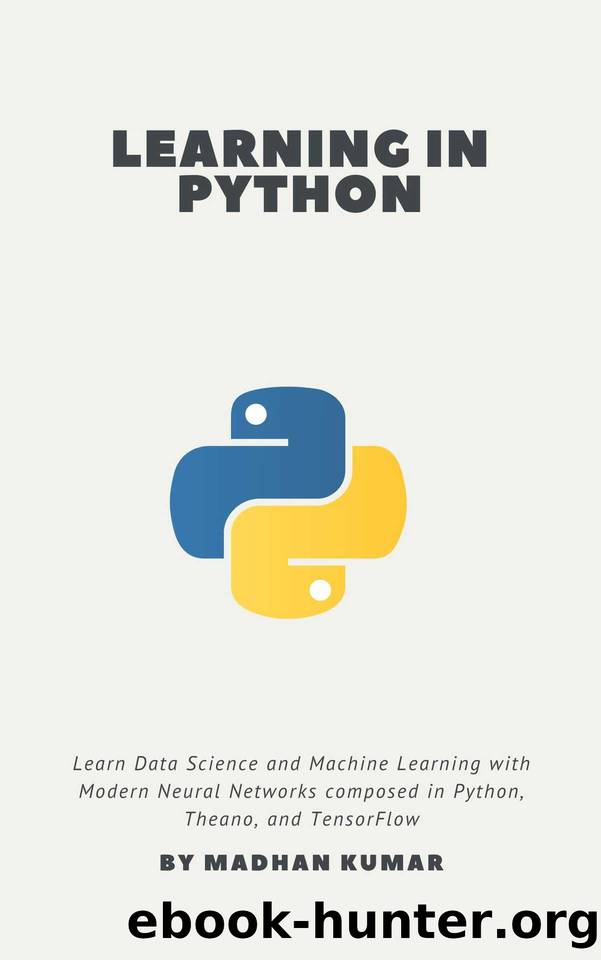Learning in Python: Learn Data Science and Machine Learning with Modern Neural Networks composed in Python, Theano, and TensorFlow by MADHAN KUMAR

Author:MADHAN KUMAR [KUMAR, MADHAN]
Language: eng
Format: azw3, epub
Published: 2020-11-05T00:00:00+00:00
A neural network in Theano
To begin with, I will characterize my information sources, yields, and loads (the loads will be shared factors):
thX = T.matrix('X')
thT = T.matrix('T')
W1 = theano.shared(np.random.randn(D, M), 'W1')
W2 = theano.shared(np.random.randn(M, K), âW2')
Notice I've added a "th" prefix to the Theano factors since I will call my real information, which are Numpy clusters, X and T.
Review that M is the number of units in the shrouded layer.
Next, I characterize the feedforward activity.
thZ = T.tanh( thX.dot(W1))
thY = T.nnet.softmax( thZ.dot(W2) )
T.tanh is a non-straight capacity like the sigmoid, however, it runs between - 1 and +1.
Next, I characterize my cost work and my expectation work (this is utilized to figure the arrangement mistake later).
cost = -(thT * T.log(thY)).sum()
prediction = T.argmax(thY, axis=1)
What's more, I characterize my updated articulations. (notice how Theano has a capacity to ascertain angles!)
update_W1 = W1 - lr*T.grad(cost, W1)
update_W2 = W2 - lr*T.grad(cost, W2)
I make train work like the basic model above:
train = theano.function(
inputs=[thX, thT],
updates=[(W1, update_W1),(W2, update_W2)],
Download
Learning in Python: Learn Data Science and Machine Learning with Modern Neural Networks composed in Python, Theano, and TensorFlow by MADHAN KUMAR.epub
This site does not store any files on its server. We only index and link to content provided by other sites. Please contact the content providers to delete copyright contents if any and email us, we'll remove relevant links or contents immediately.
Hello! Python by Anthony Briggs(10193)
The Mikado Method by Ola Ellnestam Daniel Brolund(10106)
OCA Java SE 8 Programmer I Certification Guide by Mala Gupta(10041)
Algorithms of the Intelligent Web by Haralambos Marmanis;Dmitry Babenko(8585)
Sass and Compass in Action by Wynn Netherland Nathan Weizenbaum Chris Eppstein Brandon Mathis(7965)
Grails in Action by Glen Smith Peter Ledbrook(7940)
Test-Driven iOS Development with Swift 4 by Dominik Hauser(7898)
The Well-Grounded Java Developer by Benjamin J. Evans Martijn Verburg(7836)
Windows APT Warfare by Sheng-Hao Ma(7640)
Layered Design for Ruby on Rails Applications by Vladimir Dementyev(7372)
Blueprints Visual Scripting for Unreal Engine 5 - Third Edition by Marcos Romero & Brenden Sewell(7277)
Secrets of the JavaScript Ninja by John Resig Bear Bibeault(6734)
Kotlin in Action by Dmitry Jemerov(5367)
Solidity Programming Essentials by Ritesh Modi(4458)
Hands-On Full-Stack Web Development with GraphQL and React by Sebastian Grebe(4400)
WordPress Plugin Development Cookbook by Yannick Lefebvre(4268)
Unity 3D Game Development by Anthony Davis & Travis Baptiste & Russell Craig & Ryan Stunkel(4177)
Functional Programming in JavaScript by Mantyla Dan(4166)
The Ultimate iOS Interview Playbook by Avi Tsadok(4152)
